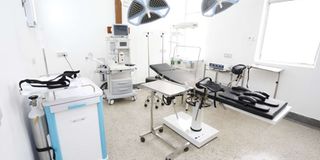New medical device to save mothers’ lives

A theater enhancing access to quality maternal healthcare services. A fully assembled device that can help prevent excessive bleeding in women after childbirth has been developed.
What you need to know:
- First low-cost, fully assembled device that can help prevent excessive bleeding in women after childbirth has been developed.
- It has received regulatory approval from the Ghana Food and Drugs Authority and the Kenya Pharmacy and Poisons Board for its use in each country.
- World Health Organisation says Postpartum haemorrhage (PPH) is the leading cause of maternal mortality in low- and middle-income countries.
The first low-cost, fully assembled device that can help prevent excessive bleeding in women after childbirth has been developed.
Global health non-profit organisations, PATH, and Sinapi Biomedical, South Africa, announced last month, that their lifesaving medical device for postpartum haemorrhage innovation, known as the Sinapi Ellavi uterine balloon tamponade, has received regulatory approval from the Ghana Food and Drugs Authority and the Kenya Pharmacy and Poisons Board for use of this medical device in each country.
Ellavi is the first commercially available, low-cost, fully assembled uterine balloon tamponade to receive internationally-recognised CE marking, signifying that the medical device meets European regulatory requirements.
Uterine balloon
Unlike condom catheter uterine balloon tamponades that are assembled at the point of care, the Ellavi device is fully assembled and uses a pressure-controlled mechanism of action to address some of the limitations of fixed-volume condom catheters, PATH said in a statement.
Postpartum haemorrhage causes of postpartum bleeding, include loss of tone in the uterine muscles, a bleeding disorder, or the placenta failing to come out completely or tearing.
According to the World Health Organisation, Postpartum haemorrhage (PPH) is the leading cause of maternal mortality in low- and middle-income countries.
Affordable
"In Sub-Saharan Africa, where the need is greatest, an affordable, preassembled uterine balloon tamponade that is easy for health providers to use in emergencies from refractory postpartum haemorrhage caused by uterine atony can help mainstream management and improve health outcomes for women,” Dr Anne B. Kihara, President of the International Federation of Gynaecology and Obstetrics said in a statement released by PATH.
PPH is a leading cause of maternal deaths globally, contributing to a quarter of the deaths annually. Women giving birth in low-resource settings are particularly at a higher risk of death than their counterparts in resource-rich environments.
The First Confidential Enquiry into Maternal Deaths in Kenya reveals that postpartum haemorrhage accounts for 34 per cent of maternal mortality.
Excessive bleeding
The enquiry into maternal deaths done between June 2015 and June 2016, found that nine out of 10 women who died of obstetric bleeding had received substandard care, and that different management of the condition would have saved their lives.
Delays in starting treatment, incorrect diagnosis, and lack of adherence to treatment protocols, are some of the factors that lead to the death of mothers from excessive bleeding after birth. The number of maternal deaths associated with PPH has been on the rise.
In 2015, Kenya reported 11,770 maternal deaths, 2,246 more than the 9,524 recorded in 2014. By October 2016, 9,854 mothers had lost their lives due to PPH across the country, data from the Kenya Health Information System (KHIS) shows.
When the placenta separates from the uterus, there are open blood vessels in the area where it was attached, which bleed into the uterus. Occasionally, the uterus doesn’t contract well after delivery, resulting in excessive blood loss, called a postpartum haemorrhage.
Clinically tested
Postpartum haemorrhage is defined as blood loss of 500ml or more within 24 hours after giving birth. Blood loss above 1,000ml within the same timeframe is considered to be more severe. Each pregnancy magnifies a mother’s risk especially if she does not have access to healthcare.
The WHO identifies uterine balloon tamponades as important tools for the treatment of severe postpartum haemorrhage when standard drug treatments fail or are not available. While national clinical guidelines for the treatment of postpartum haemorrhage in both Ghana and Kenya include uterine balloon tamponades, the use of commercially available devices has been limited, mostly due to the high cost which can run upwards of Sh43,200 for a single-use piece.
The Ellavi device will be sold at US$7.50, or the equivalent of Sh800. This cost, however, does not include varying distribution costs and country-specific tariffs.
The device was clinically tested in four hospitals in South Africa between 2016 and 2017 and in additional clinics in 2018 and 2019.
Study results demonstrated high acceptability, safety, and efficacy. In the first six months after launch, Ellavi was adopted by more than 30 South African hospitals across five provinces.





